Emphasis in Art – Exploring the Importance of Visual Emphasis
The popular adage of making something “stand out” has become quite a cliché precisely because of its undeniable value. Making certain elements stand out in art is known as visual emphasis. This visual technique has been used by artists for hundreds of years and many artists from Leonardo da Vinci to John Sargent are well-known for their mastery of it.
Contents
Focusing on Emphasis in Art
Emphasis is one of the seven principles of art. Artists use it to draw attention to specific parts of their compositions thus conveying meaning. To do this, artists use the elements of art, which include line, shape, value, color, space, and texture. By creating contrasts between these elements, artists direct the viewer’s gaze to focal points in works of art.
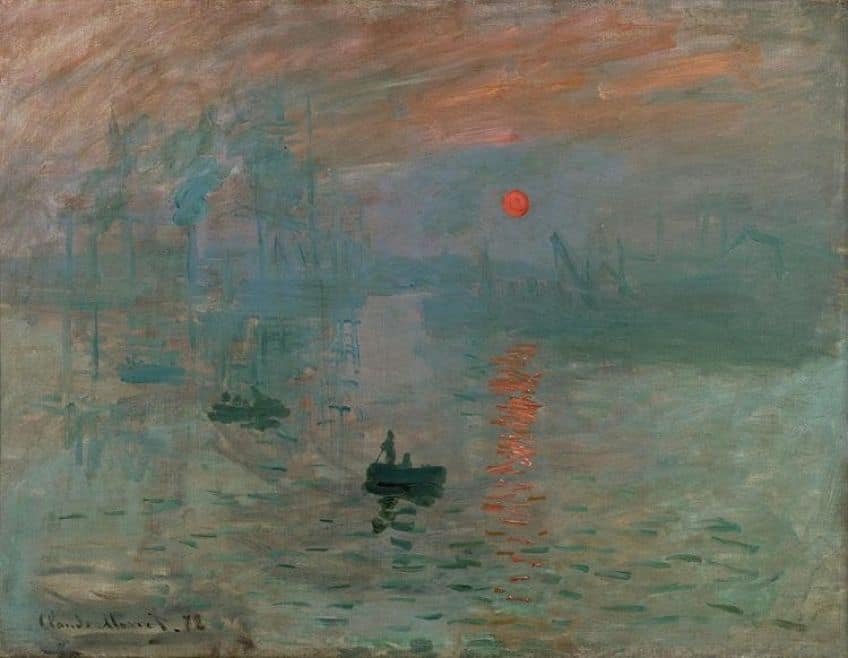
What Is Emphasis in Art?
Visual emphasis refers to an object or area in an artwork that draws the viewer’s attention. Emphasis in art is synonymous with the concept of a focal point. As the main area of interest in an artwork, emphasis or focal point captures the viewer’s attention.
Emphasis in art can be expressed in many ways, including but not limited to contrast, isolation, separation, creation of exception, subordination, or convergence.
How to Create Emphasis in Art
The different methods of creating visual emphasis use the elements and principles of art to create the focal point. For example, when one element differs from the others, it draws attention. Sometimes creating emphasis can be as simple as the placement of elements. For instance, the center of the frame is a natural area of interest in any artwork.

However, emphasis is by no means limited to these parameters. Artists may implement a myriad of emphasis techniques simultaneously or create more than one area of emphasis. Below are some examples of techniques used to create emphasis in art.
Contrast
Artists often use contrast to create focal points. Emphasis by contrast highlights elements that are different from the rest. The creation of exception and subordination can be used in tandem with emphasis. These principles draw the viewer’s eyes to the focal point. Focal points are easy to identify as they are often the area of highest contrast. Contrast is particularly effective when created through value or color.
The most basic method of emphasis is through value contrast. In terms of value contrast, it is the lighter shape that draws more emphasis.
The viewer’s gaze is manipulated by elements that have different values. The same principles that apply to value contrast are effective in color contrast. Color contrast can achieve emphasis through either isolated or complementary colors. Simply by using elements of color that differ strongly, the artist makes an area stand out thus creating emphasis.
Isolation
Isolation can operate in much the same way that contrast does as it depends on difference. There are many ways to use isolation to create emphasis. Simply placing an element further away from other elements causes it to become a focal point. For example, an image of a nighttime cityscape with a bright yellow moon in the sky above emphasizes the moon as it is both at a distance and light in a sea of darkness.
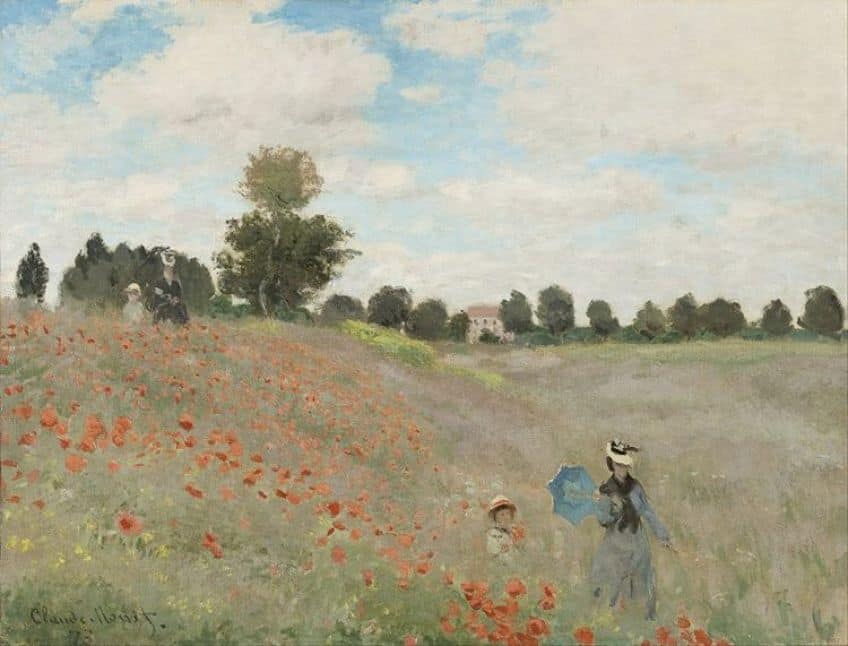
Isolated colors are another effective implementation of emphasis. In an artwork that is made up of mainly one or two colors, incorporating complementary colors, which are high in contrast, causes emphasis because of the vast difference. That said, isolated colors do not rely on complimentary colors. Any isolation of one color from the rest makes it stand out.
Convergence
Convergence refers to the creation of emphasis through leading lines. Within a composition leading lines tend to lead the viewer’s eyes. These lines can be visible or implied. They can be actual lines, the use of linear perspective, or the representation of an actual path. These lines direct the viewer’s gaze, converge towards a certain direction, or point, and create emphasis.
In an example where a figure is depicted running towards a certain point, that point becomes emphasized.
Examples of Emphasis in Art
There are many examples of emphasis in art, so a comprehensive list of emphasis art examples would be endless. Instead, we’ve chosen three examples of emphasis artworks that briefly illustrate our answer to the question: what is emphasis in art?
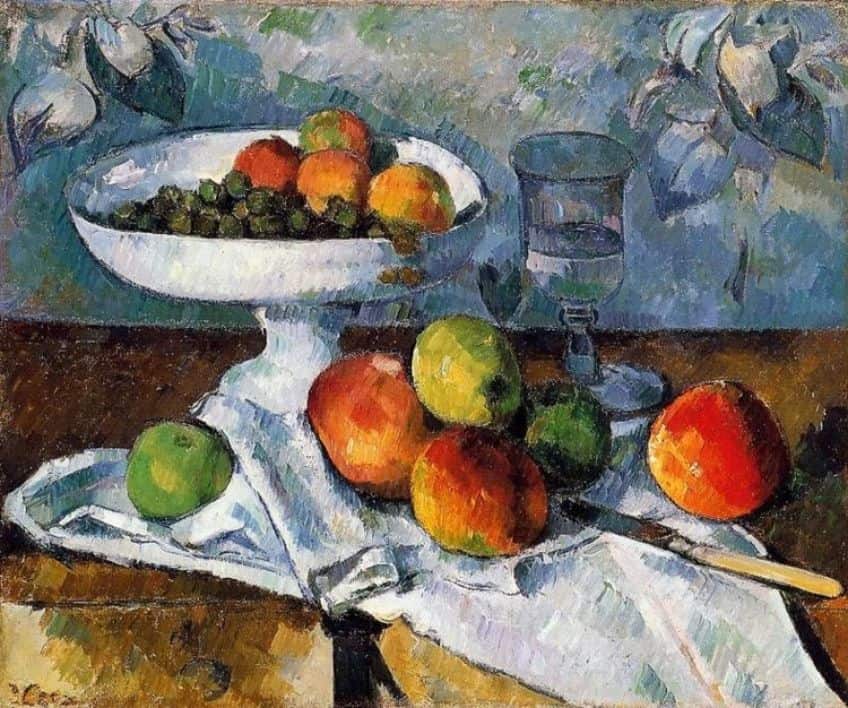
Isolation in Edward Hopper’s Nighthawks (1942)
| Painting Title | Nighthawks |
| Artist | Edward Hopper (1882 – 1967) |
| Medium | Oil on canvas |
| Dimensions (cm) | 84.1 x 152.4 |
| Current Location | Art Institute of Chicago, Chicago, United States |
One of the greatest examples of emphasis in art Nighthawks depicts an all-night diner called Phillies as the last open place in the city block. The fluorescent light from the diner emits a strange glow onto the dark street and illuminates the four figures in the room, drawing the viewer in. One server and three silent, anonymous customers, all appear to be lost in their own thoughts.
While the man and woman to the right may be assumed to be together, all the figures remain as remote from one another as they are from the viewer.
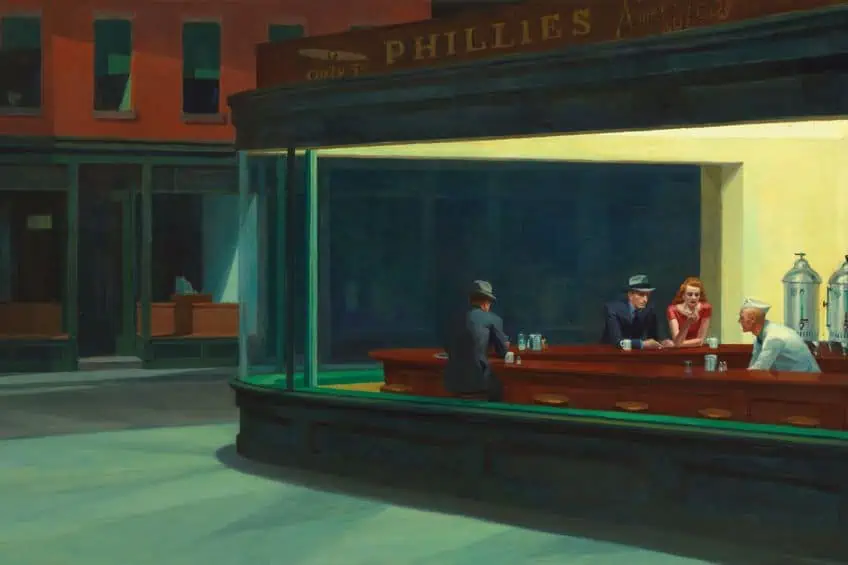
The depiction of the male figure in a fedora is what truly makes this painting an emphasis artwork. Not only do Hopper’s actual and implied lines direct the viewer’s attention to him, but he is also placed in the center of the composition. We view the man from behind, sitting alone, further isolated from the rest of the group.
The quiet distance of this focal figure reflects this artwork’s allusion to isolation both visually and figuratively.
Convergence in Jacques Louis David’s The Oath of The Horatii (1784)
| Painting Title | The Oath of The Horatii |
| Artist | Jacques Louis David (1748 – 1825) |
| Medium | Oil Paint |
| Dimensions (cm) | 330 x 425 |
| Current Location | Louvre Museum, Paris, France |
The Oath of The Horatii is an iconic example of emphasis artwork. As a neoclassical painting, it depicts a dramatized historical moment. Neoclassical paintings often featured backgrounds with dark or muted colors, taking on the appearance of a stage and making their scenes look more heroic or dramatic and thus creating emphasis.
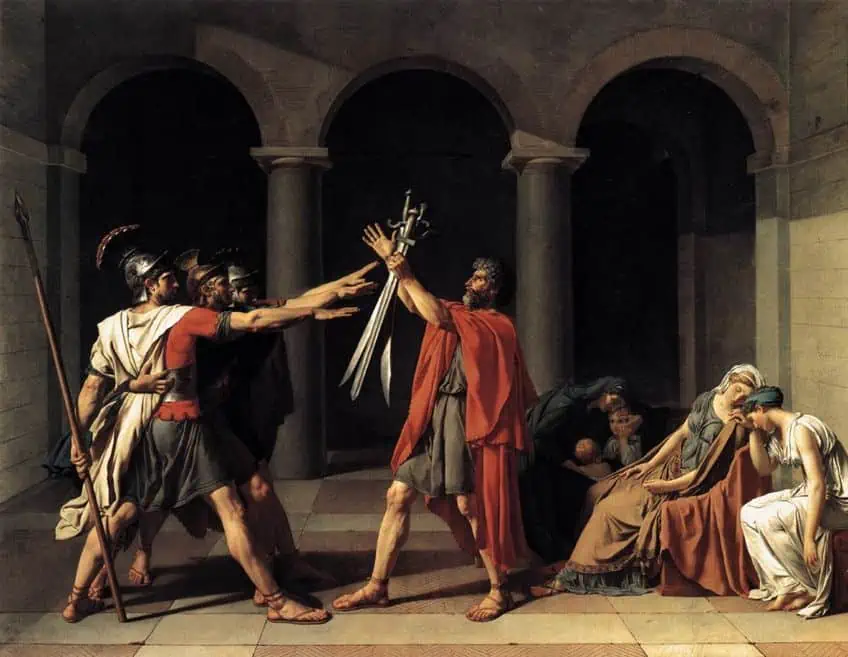
The father is the central figure in the narrative and is positioned in the center of the composition. He is wearing a large, red robe which contrasts the neutral tones in the rest of the painting. The only other figures wearing such prominent red are his sons, particularly the one closest to the viewer. All three sons are looking and gesturing dramatically at the father and the swords in his hands.
The women and children in the background mourn the men’s departure into battle, but the emphasis is on the swords.
Contrast in Rene Magritte’s The Son of Man (1964)
| Painting Title | The Son of Man |
| Artist | Rene Magritte (1898 — 1967) |
| Medium | Oil on canvas |
| Dimensions (cm) | 116 cm × 89 |
| Current Location | Private collection |
The Son of Man is a Surrealist self-portrait. Surrealist artworks were regarded as reflections of dreams or the subconscious. They would often depict objects, figures, or contexts that were bizarre or unlikely. In The Son of Man, Magritte creates emphasis through the somewhat comical use of color and contrast. In his background, the colors appear smooth and soft.
There are cool and neutral tones such as blue, gray, and cream. The horizon line between the cloudy sky and the ocean is beautifully blended.
This somber ambiance is reiterated by Magritte’s plain-clothed figure who stands in front of a short brown wall, donning a gray overcoat and a bowler hat. But the painter bends the figure’s left elbow backward, adds a bright red tie, and then obscures the figure’s face with a hovering green apple, leaving only the outer edges of the figure’s eyes visible. The complimentary colors in the foreground and the twisted arm create contrast, but it is the nonsensical placement of the apple that makes this one of the best emphasis art examples.
When an artwork has no focal point, it appears too busy or has no direction. By directing the viewer’s gaze, focal points give an artwork movement and often narrative. Emphasis imbues a strong sense of organization and allows the viewer to engage with ease. Through emphasis, artists can direct their viewers to the most important parts of their work. Therefore, emphasis can be the bridge that conveys the artist’s intention to their viewer.
Frequently Asked Questions
What Are Render Amounts in Art?
Render amounts refer to the level of detail rendered in a specific area of an artwork. Too much detail can overly unify an artwork. Therefore, an artwork requires areas of simplicity or resting spots. Finding the right balance between intricate detail and quiet simplicity depends on a mastery of the principle of emphasis.
What Is an Antithesis of Emphasis in Art?
Subordination could be regarded as the antithesis of emphasis in art. Instead of attracting attention, subordination de-emphasizes points or areas in an artwork. However, artists may use subordination in much the same way as they use emphasis. Through the de-emphasis of other areas, subordination helps highlight the main focal point.
Does Balance Contribute to Emphasis in Art?
Though they are both important principles of art, balance and emphasis are quite different. Balance suggests that the overall elements in an artwork are equal, and nothing appears too heavy or highlighted. Emphasis disrupts balance by attracting the viewer’s eye to a focal point. Often, balance requires the absence of emphasis.
Jordan Anthony is a Cape Town-based film photographer, curator, and arts writer. She holds a Bachelor of Art in Fine Arts from the University of the Witwatersrand, Johannesburg, where she explored themes like healing, identity, dreams, and intuitive creation in her Contemporary art practice. Jordan has collaborated with various local art institutions, including the KZNSA Gallery in Durban, the Turbine Art Fair, and the Wits Art Museum. Her photography focuses on abstract color manipulations, portraiture, candid shots, and urban landscapes. She’s intrigued by philosophy, memory, and esotericism, drawing inspiration from Surrealism, Fluxus, and ancient civilizations, as well as childhood influences and found objects. Jordan is working for artfilemagazine since 2022 and writes blog posts about art history and photography.
Learn more about Jordan Anthony and about us.
Cite this Article
Jordan, Anthony, “Emphasis in Art – Exploring the Importance of Visual Emphasis.” artfilemagazine – Your Online Art Source. February 23, 2023. URL: https://artfilemagazine.com/emphasis-in-art/
Anthony, J. (2023, 23 February). Emphasis in Art – Exploring the Importance of Visual Emphasis. artfilemagazine – Your Online Art Source. https://artfilemagazine.com/emphasis-in-art/
Anthony, Jordan. “Emphasis in Art – Exploring the Importance of Visual Emphasis.” artfilemagazine – Your Online Art Source, February 23, 2023. https://artfilemagazine.com/emphasis-in-art/.


